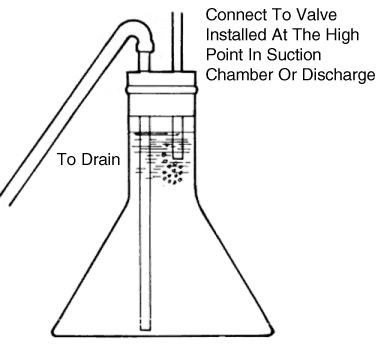Most centrifugal pumps are not designed to operate on a mixture of liquid and gases. To do so is an invitation to serious mechanical trouble, shortened life and unsatisfactory operation. The presence of only small quantities of air can result in considerable reduction in capacity, since only 2% free air will cause a 10% reduction in capacity, and 4% free air will reduce the capacity by 43.5%.
In addition to a serious toss in efficiency and wasted power, the pump may be noisy with destructive vibration. Entrained air is one of the most frequent causes of shaft breakage. It also may cause the pump to lose its prime and greatly accelerate corrosion.
Air may be present in the liquid being pumped due to leaky suction lines, stuffing boxes improperly packed, or inadequately sealed on suction lift or from other sources.
Refer also to Section 7D-7, Pumping Liquids with Entrained Gas.
TESTING FOR AIR IN CENTRIFUGAL PUMPS The amount of air which can be handled with reasonable pump life varies from pump to pump. However, in no case is it expected that a pump wilt give better life with air present than it would if the liquid were entirely air-free. The elimination of air has greatly improved the operation and life of many troublesome pumps. When trouble occurs, it is common to suspect everything but air, and to consider air last, if at alt.
If air is present, the pump is likely to operate with a certain amount of internal noise. This noise can be described as a "gravel noise" -sounds very much as though the pump were handling water full of gravel. This is the same type of noise generally associated with cavitation.
In many cases a great deal of time, inconvenience, and expense can be saved by making a simple test for the presence of air. We will assume that calculations have already been made to assure that the NPSH available is greater than that required by the pump, (the noise is not a result of cavitation). The next step should be to check for the presence of entrained air in the pumpage.
When the source of suction supply is above the centerline of the pump, a check for air leaks can be made by collecting a sample in a "bubble bottle" as illustrated. Since the pressure at the suction chamber of the pump is above atmospheric pressure, a valve can be installed in one of the tapped openings at the high point in the chamber and liquid can be fed into the "bubble bottle." The presence of air or vapor will show itself in the "bubble bottle."

Obviously, the next step is to eliminate the source of air since quantities present insufficient amount to be audible are almost certain to cause premature mechanical failure.
NOTE: The absence of bubbles is not proof that the pumpage doesn't contain air.


